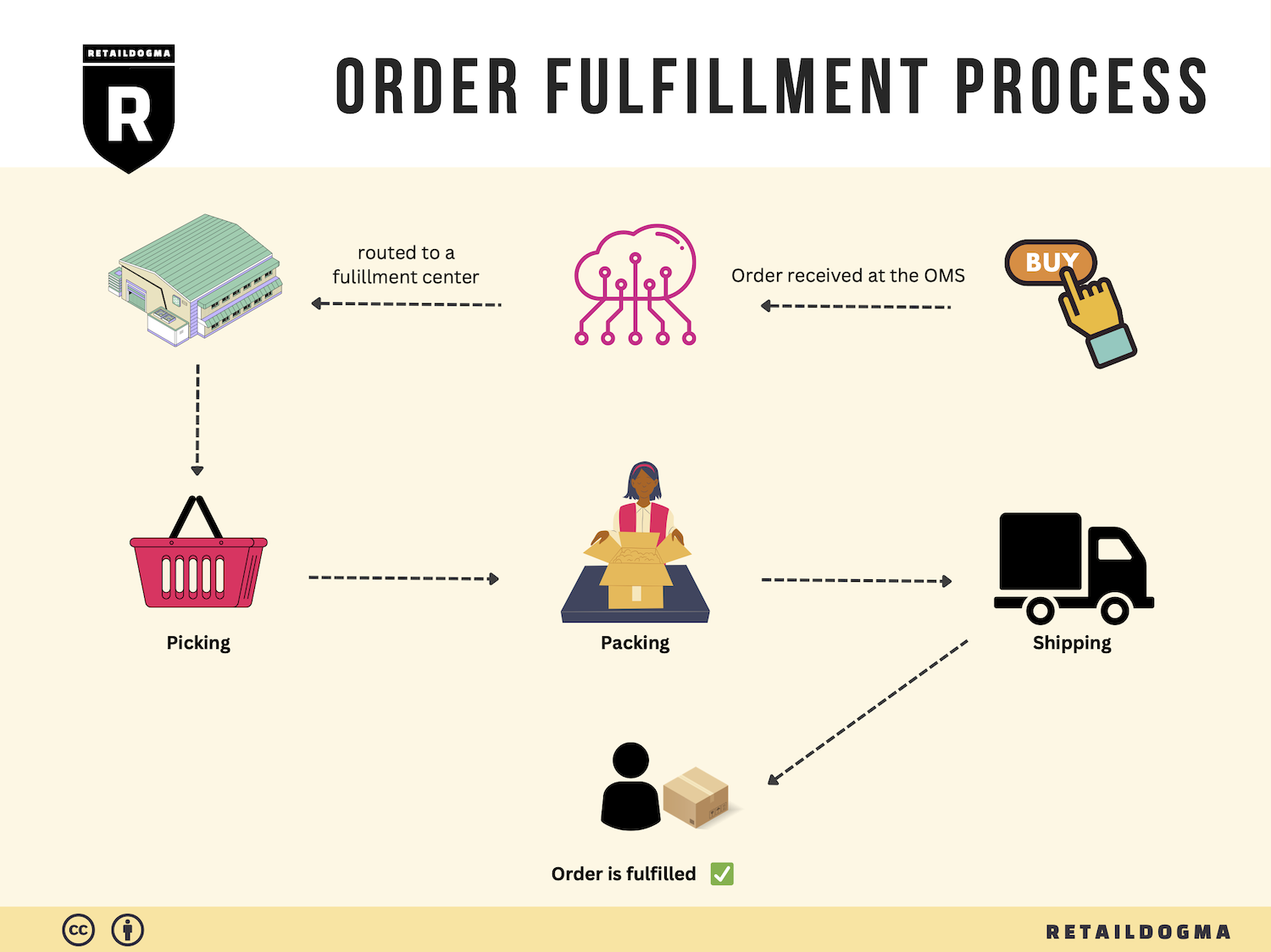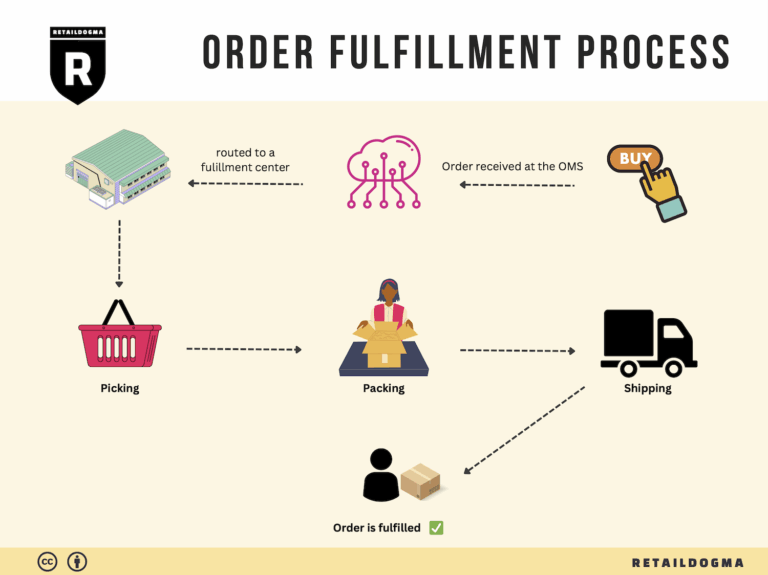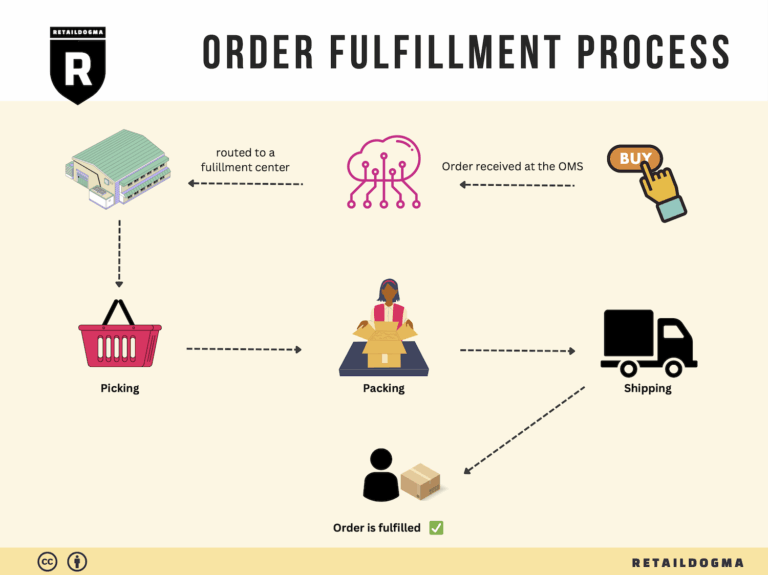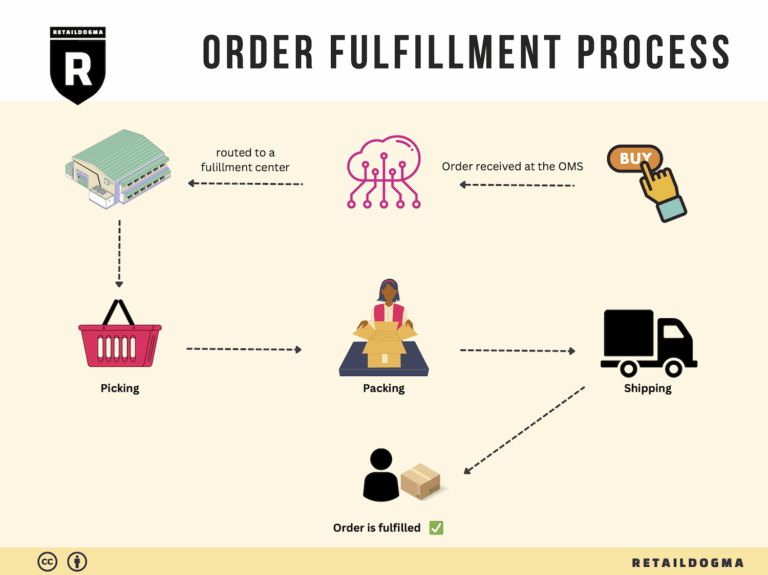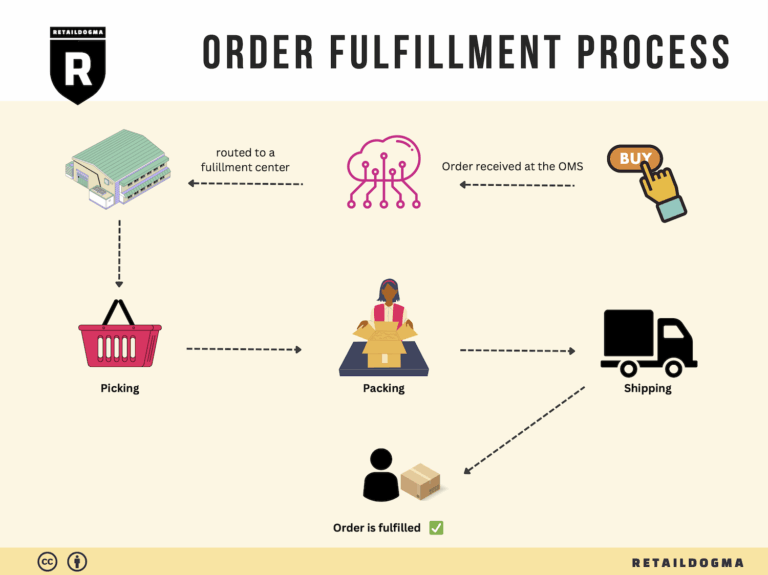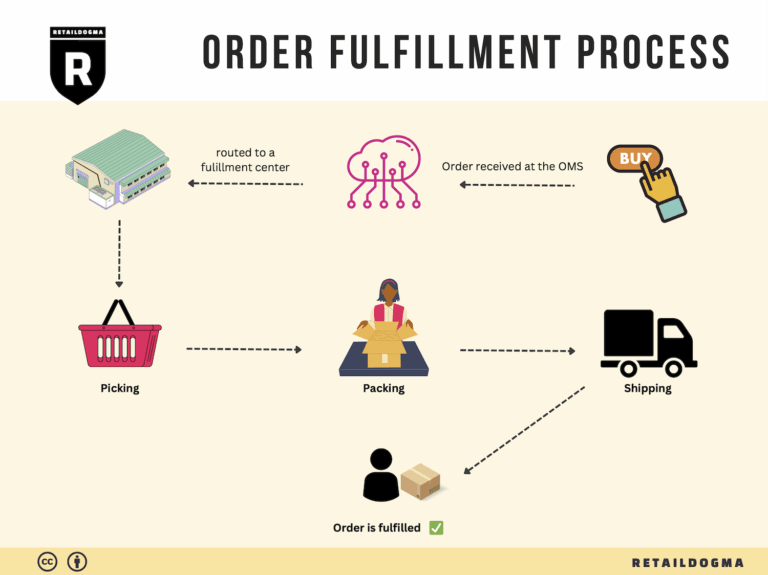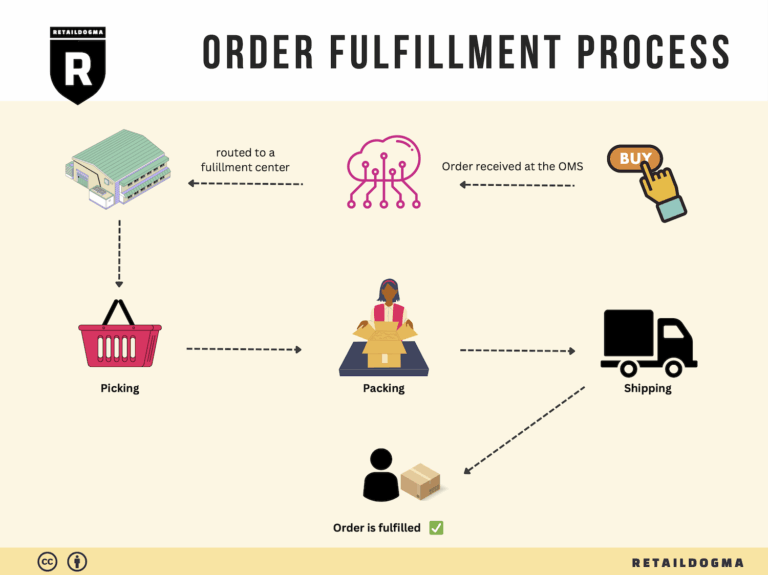Ecommerce Fulfillment Services: The Ultimate Guide (2025)
What is E-commerce Fulfillment? An Introduction for Growing Businesses
Understanding the Fulfillment Process
As a growing online business, you may find yourself overwhelmed by the demands of packing and shipping orders. This challenge can become particularly daunting as your sales increase, leading to potential delays, errors, and customer dissatisfaction. At its core, e-commerce fulfillment is simply the process of getting a product from your store to your customer’s doorstep. However, it encompasses much more than just shipping; it involves inventory management, order processing, and customer service, all of which are critical to your business’s success.
In this guide, we will explore various aspects of e-commerce fulfillment that every business owner should understand. We will start by discussing the different fulfillment models available, including Third-Party Logistics (3PL) and Fulfillment by Amazon (FBA). Each model has its advantages and disadvantages, and understanding them will help you choose the right approach for your business needs.
Next, we will delve into the core services offered by fulfillment providers, such as inventory storage, order picking and packing, shipping, and returns management. Knowing what services are available can help you streamline your operations and improve your customer experience.
Choosing the right fulfillment partner is crucial. We’ll provide you with practical tips on what to look for in a fulfillment provider, including their technology capabilities, service level agreements (SLAs), and customer support. A well-chosen partner can significantly enhance your operational efficiency and scalability.
Pricing is another critical consideration. We will break down the various cost structures associated with fulfillment services, helping you understand how to budget for these expenses and identify opportunities for cost savings.
Ultimately, the goal of this guide is to empower you, the business owner, to make informed decisions about your logistics strategy. By understanding the intricacies of e-commerce fulfillment, you can optimize your operations, enhance customer satisfaction, and scale your business effectively. Whether you are new to e-commerce or looking to refine your existing processes, this guide will serve as a valuable resource on your journey toward efficient fulfillment and growth.
What You’ll Learn In This Guide
- What is E-commerce Fulfillment? An Introduction for Growing Businesses
- The Order Fulfillment Process: From ‘Buy’ Button to Customer’s Door
- Comparing Fulfillment Models: In-House vs. 3PL vs. Dropshipping
- A Deep Dive into Amazon FBA: Pros, Cons, and Who It’s For
- Core Services Offered by Fulfillment Centers
- How to Choose a Fulfillment Partner: A 6-Point Checklist
- Understanding Fulfillment Pricing: A Breakdown of Common Fees
- Frequently Asked Questions (FAQs) about Fulfillment
- Conclusion: Is Outsourcing Fulfillment the Right Move for Your Business?
- Important Disclaimer
The Order Fulfillment Process: From ‘Buy’ Button to Customer’s Door
1. Receiving Inventory
The first step in the order fulfillment process is receiving inventory. This stage involves the acceptance of products from suppliers into your fulfillment center. As shipments arrive, they are checked against purchase orders to ensure that the correct quantities and types of items have been delivered. This verification process is crucial because it establishes the foundation for inventory accuracy and helps prevent stock discrepancies that can lead to fulfillment delays or errors.
A key term associated with this step is SKU (Stock Keeping Unit), a unique identifier assigned to each product variant. Proper SKU management during the receiving process ensures that inventory is accurately tracked, which is essential for maintaining optimal stock levels and meeting customer demand.
2. Warehouse Storage
Once inventory is received and verified, the next step is warehouse storage. This involves organizing and storing products in designated locations within the fulfillment center. Efficient storage practices can significantly impact fulfillment speed and operational efficiency. Products should be stored in a manner that maximizes space while allowing easy access for future order picking.
The importance of this step lies in its ability to streamline the subsequent processes. By utilizing slotting, a method that involves placing frequently sold items closer to the packing area, businesses can reduce the time it takes to retrieve products. This strategic organization can lead to quicker turnaround times for orders, enhancing overall customer satisfaction.
3. Order Picking
Order picking is the process of selecting items from the warehouse to fulfill customer orders. When a customer places an order, the fulfillment center generates a pick list, which outlines the specific items and quantities needed. This list guides warehouse staff in efficiently locating and gathering products.

The importance of order picking cannot be overstated; it directly influences order accuracy and fulfillment speed. Techniques such as batch picking, where multiple orders are picked simultaneously, or wave picking, which organizes picks based on shipping schedules, can enhance efficiency. Implementing these strategies can lead to improved productivity and reduced labor costs, ultimately benefiting the bottom line.
4. Order Packing
After items have been picked, they must be packed for shipment. This step involves carefully placing the selected products into shipping boxes, ensuring they are secure and protected during transit. Packing also includes attaching shipping labels and any necessary documentation, such as invoices or return slips.
The significance of order packing lies in its role in ensuring that customers receive their products in perfect condition. Proper packing techniques, such as using the right size box and appropriate cushioning materials, minimize the risk of damage during shipping. Additionally, incorporating packaging slips can improve customer experience by providing essential order information. An efficient packing process can reduce shipping costs and enhance delivery speed, further contributing to customer satisfaction.
5. Shipping & Delivery
The final step in the order fulfillment process is shipping and delivery. Once orders are packed, they are prepared for shipment via chosen carriers. This stage involves selecting the most cost-effective and timely shipping options based on customer preferences and delivery locations. Many fulfillment centers, like those operated by ShipBob, utilize advanced algorithms to determine the best shipping methods and routes.
Shipping is critical not only for getting products to customers but also for maintaining a positive brand reputation. Timely delivery is a key factor in customer satisfaction, and delays can lead to negative reviews or loss of repeat business. A term closely related to this step is SLA (Service Level Agreement), which defines the expected delivery times and service standards between the fulfillment provider and the business. Meeting or exceeding SLAs can significantly enhance customer trust and loyalty.
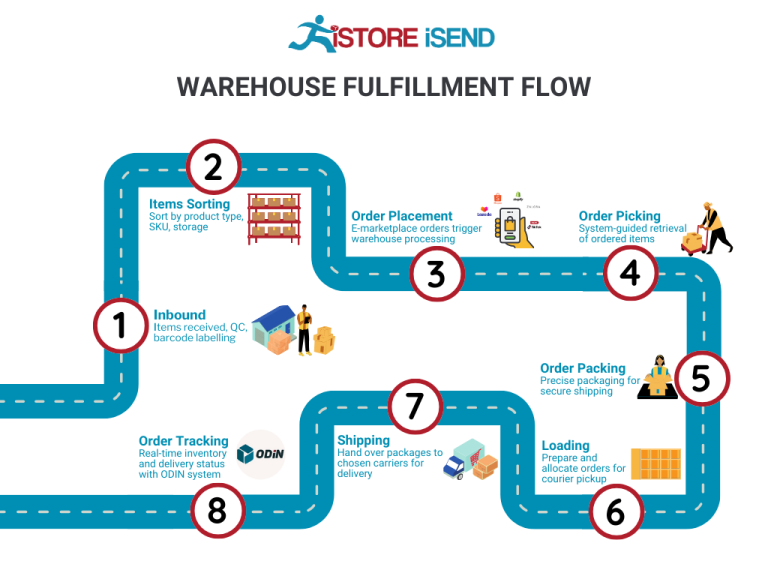
By understanding and effectively managing each of these five steps in the order fulfillment process, e-commerce businesses can streamline operations, reduce costs, and ultimately improve customer satisfaction. Implementing best practices at each stage ensures that orders are fulfilled accurately and efficiently, paving the way for scalable growth in a competitive market.
Comparing Fulfillment Models: In-House vs. 3PL vs. Dropshipping
Fulfillment Model Comparison
| Model | Who Handles Inventory | Best For (Business Stage) | Key Advantage | Key Disadvantage |
|---|---|---|---|---|
| In-House Fulfillment | Business Owner | Established Brands | Full control over inventory and operations | High overhead costs and resource-intensive |
| Third-Party Logistics (3PL) | 3PL Provider | Growing Brands | Cost-effective and scalable logistics solutions | Less control over inventory and processes |
| Dropshipping | Supplier | Startups and Small Businesses | Low upfront costs and minimal inventory risk | Lower profit margins and longer shipping times |
In-House Fulfillment
In-house fulfillment is a model where businesses manage their own inventory and logistics operations. This typically involves owning or leasing warehouse space, hiring staff for picking, packing, and shipping orders, and utilizing logistics partners for transportation. This model is best suited for established brands with sufficient volume to justify the investment in infrastructure and labor.
The key advantage of in-house fulfillment is the level of control it provides. Businesses can oversee every aspect of the fulfillment process, from inventory management to shipping, ensuring that quality standards are met and customer expectations are exceeded. This direct oversight can lead to enhanced customer service and brand consistency. However, the disadvantages are significant; the costs associated with warehousing, staffing, and managing logistics can be substantial. Additionally, as order volumes fluctuate, businesses may struggle with excess capacity or insufficient resources, leading to operational inefficiencies.
Third-Party Logistics (3PL)
Third-party logistics (3PL) involves outsourcing fulfillment to a specialized provider that manages inventory, warehousing, and shipping on behalf of the business. This model is particularly advantageous for growing brands that need to scale quickly without the heavy investment in logistics infrastructure.
One of the primary benefits of partnering with a 3PL is the cost-effectiveness and scalability it offers. 3PL providers like ShipBob have extensive networks of fulfillment centers, allowing businesses to distribute inventory strategically across regions, which can significantly reduce shipping costs and delivery times. Furthermore, 3PLs often provide sophisticated technology solutions for order tracking, inventory management, and analytics, which can enhance operational efficiency. However, businesses lose some control over their inventory and fulfillment processes, which can lead to potential issues with accuracy and customer service if the 3PL does not meet expectations.
Dropshipping
Dropshipping is a fulfillment model where the retailer does not hold inventory but instead relies on suppliers to ship products directly to customers. This approach is particularly popular among startups and small businesses that want to minimize upfront costs and inventory risk.
The primary advantage of dropshipping is the low barrier to entry. Entrepreneurs can start an e-commerce business without significant investment in inventory or warehousing, allowing them to focus on marketing and customer acquisition. Additionally, the model allows for a wide variety of products to be offered without the need for upfront purchase. However, dropshipping has its drawbacks, including lower profit margins due to reliance on suppliers and potentially longer shipping times, which can impact customer satisfaction. Furthermore, businesses have limited control over inventory levels and fulfillment processes, which can lead to stockouts or delays that harm the brand’s reputation.
Conclusion
Choosing the right fulfillment model is critical for e-commerce businesses looking to scale effectively. Each model—In-house, 3PL, and Dropshipping—has its unique advantages and challenges. In-house fulfillment provides complete control but at a higher cost, while 3PL offers scalability and efficiency at the expense of some control. Dropshipping allows for low-risk entry into e-commerce but often results in lower margins and longer fulfillment times. Understanding these models’ intricacies will help business owners make informed decisions that align with their growth strategies and operational capabilities.
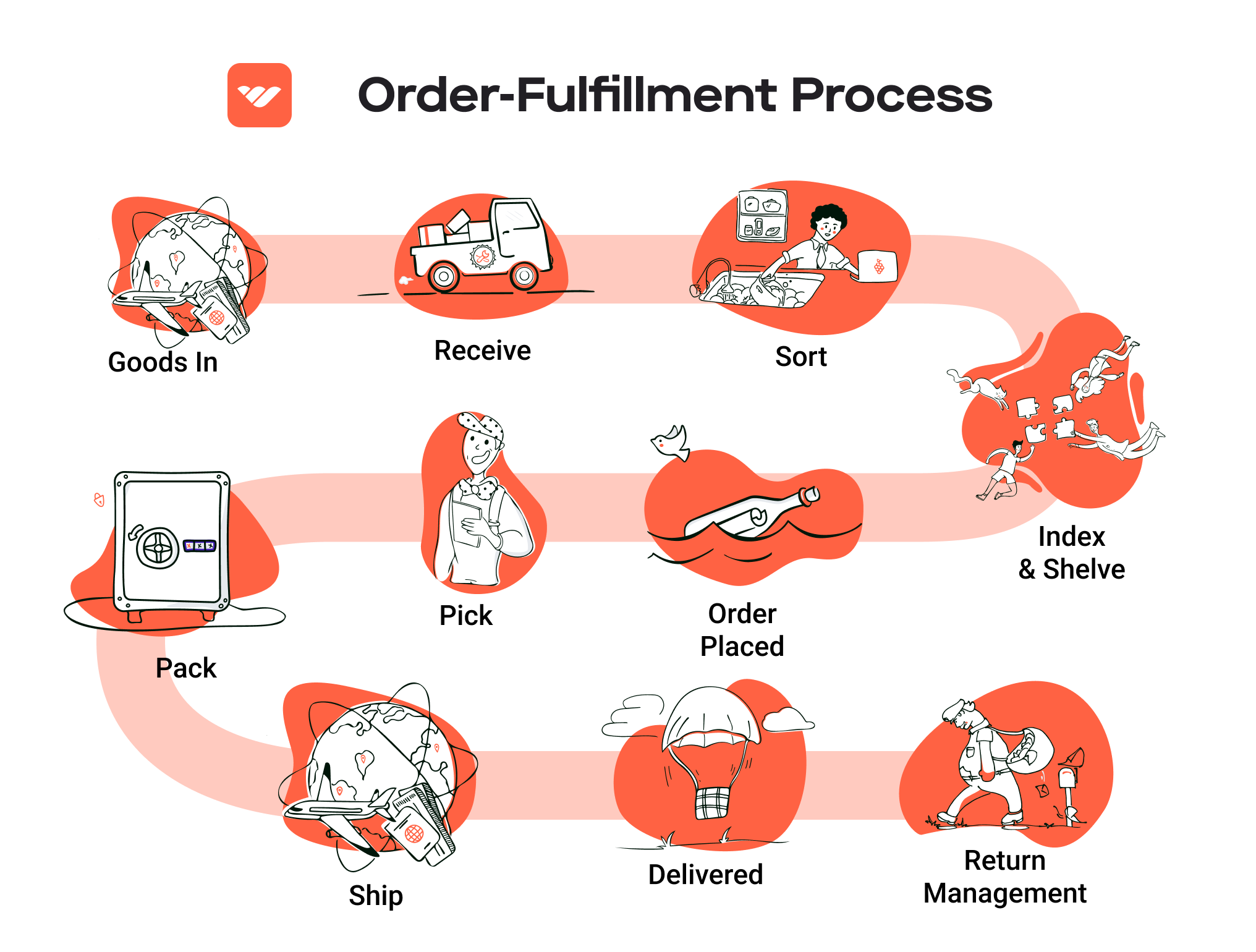
A Deep Dive into Amazon FBA: Pros, Cons, and Who It’s For
Understanding Fulfillment by Amazon (FBA)
Fulfillment by Amazon (FBA) is a service offered by Amazon that allows sellers to store their products in Amazon’s fulfillment centers. Amazon then takes care of storage, packaging, and shipping, as well as customer service and returns for these products. This service provides a streamlined way for sellers to reach millions of customers while leveraging Amazon’s vast logistics network.
How FBA Works
-
Set Up: Sellers create an Amazon seller account and enroll in FBA. They can then list their products and choose which items to fulfill through Amazon.
-
Shipping Inventory: Sellers prepare their inventory and ship it to Amazon’s fulfillment centers. Amazon provides guidance on how to label and package products to meet their requirements.
-
Storage: Once the inventory arrives at the fulfillment center, Amazon stores the products until they are sold.
-
Order Processing: When a customer orders a product, Amazon handles the entire fulfillment process, including picking, packing, and shipping the item directly to the customer.
-
Customer Service: Amazon manages all customer inquiries and returns related to FBA products, allowing sellers to focus on other aspects of their business.
-
Payment: After a sale is made, Amazon deducts its fees and deposits the remaining amount into the seller’s account.
Pros of Using FBA
-
Prime Eligibility: Products fulfilled by Amazon are eligible for Amazon Prime, which can lead to increased visibility and sales. Prime members often prefer products with fast, free shipping, making FBA a significant advantage for sellers.
-
Customer Trust: Leveraging Amazon’s established brand and customer service can instill trust in buyers. Customers are more likely to purchase from sellers using FBA due to Amazon’s reputation for reliability and quality service.
-
Multi-Channel Fulfillment: FBA allows sellers to fulfill orders from other sales channels, such as their own website or eBay, using Amazon’s logistics. This means sellers can maintain inventory in one place and streamline their operations.
-
Scalability: FBA provides a scalable solution for growing businesses. As sales increase, sellers can easily send more inventory to Amazon without having to invest in their own warehousing or logistics.
-
Time Savings: By outsourcing fulfillment to Amazon, sellers can save time on logistics, allowing them to focus on marketing, product development, and growing their business.
Cons of Using FBA
-
High Fees: FBA comes with various fees, including storage fees, fulfillment fees, and additional charges for long-term storage. These costs can significantly impact profit margins, especially for low-cost items.
-
Strict Inventory Rules: Amazon has stringent inventory management policies, including limits on how much inventory can be sent to their fulfillment centers. Sellers must also adhere to guidelines regarding product condition and packaging, which can be challenging for some businesses.
-
Commingling Risks: FBA products from different sellers are often stored together in the same fulfillment center. This commingling can lead to issues if a seller’s inventory is mixed with defective or unsold products from other sellers, potentially damaging their reputation.
-
Loss of Control: By using FBA, sellers give up some control over their inventory and customer service. Any issues related to fulfillment or returns are handled by Amazon, which may not always align with the seller’s preferred approach.
-
Potential for Stockouts: If a seller’s inventory is not managed effectively, they may experience stockouts, leading to lost sales and reduced visibility on the Amazon platform.
Who is FBA Best For?
Fulfillment by Amazon is particularly beneficial for specific types of sellers:
-
Small to Medium-Sized Businesses: Those looking to scale quickly without investing heavily in logistics and warehousing can greatly benefit from FBA’s infrastructure.
-
Brands with High Sales Volume: Sellers with a high volume of orders or those who sell seasonal products can leverage FBA to handle surges in demand efficiently.
-
New Entrants to E-commerce: Entrepreneurs new to e-commerce can take advantage of Amazon’s established customer base and logistics expertise to gain a foothold in the market.
-
Sellers of Unique or Niche Products: Brands that offer unique items that may not have widespread recognition can benefit from the trust and visibility associated with FBA.
-
Multi-Channel Sellers: Businesses that sell across various platforms can utilize FBA for streamlined logistics, allowing them to fulfill orders from multiple channels without managing separate inventories.
In conclusion, Fulfillment by Amazon offers a powerful platform for e-commerce sellers looking to scale their operations. While the benefits of Prime eligibility, customer trust, and time savings are compelling, sellers must also weigh the costs and challenges associated with FBA. For the right businesses, FBA can be a game-changer, enabling them to focus on growth while Amazon handles the complexities of fulfillment.
Core Services Offered by Fulfillment Centers
Inventory Management & Warehousing
Inventory management and warehousing form the backbone of any successful e-commerce operation. Fulfillment centers offer dedicated storage solutions where businesses can keep their products in a secure, organized manner. This service typically includes advanced inventory tracking systems that provide real-time visibility into stock levels, enabling e-commerce businesses to monitor their inventory without the need for extensive manual oversight.
The primary benefit of efficient inventory management is the ability to reduce carrying costs. Businesses can avoid overstocking or stockouts, both of which can lead to lost sales or excess inventory costs. With sophisticated software that integrates with e-commerce platforms, fulfillment centers can automatically alert businesses when stock is low, ensuring timely replenishment and maintaining optimal inventory levels. Furthermore, strategic placement of inventory across multiple fulfillment centers allows for faster shipping times and reduced shipping costs, ultimately enhancing customer satisfaction.
Pick and Pack Services
Pick and pack services are critical for ensuring that orders are processed quickly and accurately. Once an order is placed, fulfillment centers utilize systematic processes to “pick” the ordered items from the warehouse shelves and “pack” them for shipment. This involves not only gathering the correct items but also ensuring that they are packaged securely to prevent damage during transit.
The benefits of pick and pack services are manifold. First and foremost, they significantly speed up the order fulfillment process, which is essential for meeting customer expectations in today’s fast-paced e-commerce environment. With a high accuracy rate, fulfillment centers can minimize errors in order fulfillment, reducing the potential for returns and improving customer trust. Additionally, many fulfillment centers offer custom packaging options, allowing businesses to maintain their branding and enhance the unboxing experience for customers. This can lead to increased customer loyalty and repeat purchases.
Kitting and Assembly
Kitting and assembly is a specialized service that involves grouping individual items together to create a single product or package. This is particularly useful for e-commerce businesses that offer bundled products or require assembly before shipping. Fulfillment centers can manage this process, ensuring that the right items are combined and packaged correctly.
The key advantage of kitting and assembly services is the ability to streamline operations. By outsourcing this process, businesses can save valuable time and resources that would otherwise be spent on manual assembly. This efficiency can also lead to cost savings, as fulfillment centers often have the expertise and resources to handle kitting at a lower cost than businesses could achieve in-house. Furthermore, offering bundled products can enhance sales opportunities and improve the overall customer experience, as consumers are often attracted to the convenience of purchasing multiple items in one package.
Returns Management (Reverse Logistics)
Returns management, or reverse logistics, is a vital service provided by fulfillment centers that addresses the complexities of handling product returns. This process involves managing returned items, restocking them, and processing refunds or exchanges. Effective returns management is crucial for maintaining customer satisfaction and loyalty, especially in the e-commerce sector, where return rates can be significantly higher than in traditional retail.
The benefits of a well-managed returns process are substantial. First, it helps to streamline the return experience for customers, making it easy for them to send back products and receive refunds or exchanges promptly. This ease of process can reduce friction and enhance customer trust in a brand. Additionally, fulfillment centers can often resell returned items that are in good condition, recouping some of the costs associated with returns. By efficiently managing returns, e-commerce businesses can maintain positive relationships with customers, ultimately leading to increased customer retention and higher lifetime value.
In summary, leveraging the core services offered by fulfillment centers can provide significant advantages for e-commerce businesses. By focusing on inventory management, pick and pack services, kitting and assembly, and returns management, businesses can enhance their operational efficiency, improve customer satisfaction, and ultimately scale their logistics as they grow.
How to Choose a Fulfillment Partner: A 6-Point Checklist
Location & Warehouse Network
Importance:
The geographical location of a fulfillment partner’s warehouses directly impacts shipping speed and costs. A partner with a well-distributed network can reduce delivery times and improve customer satisfaction.
Questions to Ask:
– How many fulfillment centers do you operate, and where are they located?
– Can you provide a map or list of your warehouse locations?
– How do you determine which warehouse will fulfill an order?
– Do you have plans to expand your warehouse network in the near future?
Technology & Integrations
Importance:
In today’s digital landscape, the ability to seamlessly integrate your e-commerce platform with your fulfillment partner’s technology is crucial. Advanced technology enables real-time inventory tracking, order processing, and efficient communication.
Questions to Ask:
– What order management system (OMS) do you use, and how does it integrate with popular e-commerce platforms (like Shopify, WooCommerce, etc.)?
– Do you provide a dashboard for tracking orders and inventory levels?
– What reporting and analytics capabilities do you offer?
– Are there any additional costs for software integrations?
Specializations (e.g., Cold Storage, Oversized Items)
Importance:
Not all fulfillment centers can handle specific product types, such as perishable goods or oversized items. Understanding a partner’s specializations ensures that your products are stored and handled appropriately.
Questions to Ask:
– What types of products do you specialize in handling?
– Do you have capabilities for temperature-sensitive items or unique packaging requirements?
– How do you manage inventory for specialized products?
– Can you accommodate seasonal fluctuations in inventory for specialized products?
Scalability & Capacity
Importance:
As your business grows, your fulfillment partner must be able to scale operations to meet increasing demand. A partner with flexible capacity can adapt to your growth without compromising service quality.
Questions to Ask:
– How do you handle peak seasons or unexpected surges in order volume?
– What is your maximum capacity for order fulfillment?
– Can you provide examples of how you have scaled operations for other clients?
– Are there any limitations to your scalability in terms of space or resources?
Pricing and Contracts
Importance:
Transparent pricing structures and flexible contract terms are essential for budgeting and financial planning. Understanding the total cost of fulfillment helps you avoid hidden fees and ensures that you maintain healthy profit margins.
Questions to Ask:
– Can you provide a detailed breakdown of your pricing model (e.g., storage fees, pick and pack fees, shipping costs)?
– Are there any additional fees that I should be aware of (e.g., for returns, special handling)?
– What are your contract terms, and is there flexibility for renegotiation as my business evolves?
– Do you offer discounts for long-term contracts or higher volumes?
Customer Support & Reviews
Importance:
Strong customer support can make or break your experience with a fulfillment partner. Reliable support ensures that you can quickly resolve issues and maintain smooth operations. Additionally, reviews from other businesses can provide insight into the partner’s reliability and service quality.
Questions to Ask:
– What customer support channels do you offer (e.g., phone, email, chat)?
– What are your typical response times for support inquiries?
– Can you provide references or case studies from other clients in my industry?
– How do you handle issues like lost packages or shipping delays?
Conclusion
Choosing the right fulfillment partner is a critical decision that can significantly impact your e-commerce business’s growth and customer satisfaction. By using this checklist, you can systematically evaluate potential partners and ensure that they align with your operational needs and business goals. Remember, the right partner should not only meet your current requirements but also be adaptable to support your future growth.
Understanding Fulfillment Pricing: A Breakdown of Common Fees
Initial Setup Fees
When partnering with a fulfillment center, initial setup fees are often incurred. These fees cover the onboarding process, which includes integrating your e-commerce platform with the fulfillment center’s system, setting up your account, and inputting your product information. The cost can vary depending on the complexity of your inventory and the level of customization required for your operations. Typically, this fee may range from a few hundred to a few thousand dollars, depending on the provider.
To minimize initial costs, consider asking potential partners about waivers or discounts for the setup fees, especially if you anticipate a long-term partnership. Moreover, ensure that the fulfillment center offers a seamless integration process, as this can save both time and money in the long run.
Receiving Fees
Receiving fees are charged for the process of accepting and inspecting your inventory upon arrival at the fulfillment center. This includes unloading, counting, and placing items into storage. Receiving fees can be calculated based on the number of pallets, cartons, or individual items received, with rates typically ranging from $10 to $50 per pallet or a set fee per item.
To manage these costs effectively, consider consolidating shipments to minimize the frequency of deliveries. This approach not only reduces receiving fees but can also improve your inventory management efficiency. Additionally, ensure that your products are labeled correctly to expedite the receiving process, as inaccuracies can lead to additional charges.
Storage Fees (per pallet/bin)
Storage fees are charged for keeping your inventory at the fulfillment center. These fees can be structured in various ways, including per pallet, per bin, or per item. Typically, storage fees range from $15 to $50 per pallet per month, depending on the facility’s location and the volume of inventory stored.
To optimize storage costs, evaluate your inventory turnover rates. If certain items are not selling quickly, consider implementing strategies to reduce excess stock, such as promotions or discounts. Additionally, inquire about seasonal storage rates, as many fulfillment centers offer lower fees during off-peak periods.
Pick & Pack Fees (per item/order)
Pick and pack fees are charged for the labor involved in selecting items from inventory and packaging them for shipment. These fees can be calculated on a per-item or per-order basis. For instance, you might encounter charges ranging from $0.50 to $3.00 per item, or a flat fee per order, which can vary based on the complexity of the packaging.
To reduce pick and pack fees, consider optimizing your product listings to streamline the picking process. For example, grouping similar items together or using standardized packaging can speed up fulfillment times. Additionally, evaluate whether your fulfillment partner offers volume discounts for larger order sizes, which can significantly lower your costs.
Shipping Fees
Shipping fees are one of the most variable costs associated with fulfillment services. These fees depend on several factors, including the shipping method (standard, expedited, or same-day), package weight and dimensions, destination, and the carrier used. Shipping fees can range from a few dollars for local deliveries to over $50 for international shipments.
To manage shipping costs effectively, consider implementing a multi-carrier strategy that allows you to choose the most cost-effective option for each shipment. Many fulfillment centers also offer discounted shipping rates due to their volume, so inquire about these savings. Additionally, utilizing fulfillment centers located closer to your customer base can significantly reduce shipping times and costs.
Tips for Getting an Accurate Quote
To obtain an accurate quote from a fulfillment center, follow these practical tips:
-
Provide Detailed Information: Share specifics about your product types, order volumes, and any special handling requirements. The more information you provide, the more accurate the quote will be.
-
Ask About All Fees: Inquire about all potential fees, including initial setup, receiving, storage, pick & pack, and shipping fees. Some fulfillment centers may have hidden costs that can significantly impact your total expenses.
-
Request Sample Pricing: If possible, ask for sample pricing based on your expected order volume and types of products. This can help you understand how fees scale with your business growth.
-
Negotiate Terms: Don’t hesitate to negotiate fees, especially if you’re planning to bring significant volume to the partnership. Many fulfillment centers are open to adjusting terms to secure your business.
-
Compare Multiple Providers: Finally, always compare quotes from several fulfillment centers to ensure you’re getting competitive pricing. Look beyond just the cost; consider service quality, accuracy rates, and shipping options as well.
By understanding these common fulfillment pricing models and following these tips, e-commerce business owners can make informed decisions that lead to cost-effective and efficient logistics operations.
Frequently Asked Questions (FAQs) about Fulfillment
1. What is a fulfillment center?
A fulfillment center is a specialized facility where e-commerce businesses store their inventory and process orders for shipment. Unlike traditional warehouses, fulfillment centers focus on efficiently picking, packing, and shipping products directly to customers, often utilizing advanced technology to streamline operations.
2. What’s the difference between a warehouse and a fulfillment center?
While both warehouses and fulfillment centers store goods, their functions differ significantly. A warehouse primarily serves as a storage space for inventory, often focusing on bulk storage and long-term holding. In contrast, a fulfillment center is designed for fast-paced order processing, picking, packing, and shipping directly to customers, making it essential for e-commerce operations.
3. What is a 3PL (Third-Party Logistics)?
A 3PL is a service provider that handles logistics and supply chain functions on behalf of a business. This includes warehousing, order fulfillment, transportation, and sometimes even inventory management. Partnering with a 3PL can help businesses scale efficiently by outsourcing complex logistics tasks to experts.
4. How much do fulfillment services cost?
Fulfillment service costs vary based on factors such as order volume, storage needs, and specific services required. Typically, costs include storage fees, picking and packing fees, shipping charges, and additional service fees for handling returns or special packaging. It’s advisable to request quotes from multiple providers to compare pricing structures and find a solution that fits your budget.
5. What are the benefits of using a US fulfillment center?
Utilizing a US fulfillment center allows businesses to reach a vast consumer market quickly and cost-effectively. Benefits include faster shipping times, reduced shipping costs through regional distribution, enhanced customer satisfaction with reliable delivery, and the ability to scale operations without the overhead of managing in-house logistics.
6. How do I choose the right fulfillment center for my business?
When selecting a fulfillment center, consider factors such as location, scalability, technology integration, shipping options, pricing structure, and customer service. Evaluate their experience with your industry and review customer testimonials to ensure they align with your business needs and growth plans.
7. How does inventory management work in a fulfillment center?
Inventory management in a fulfillment center involves tracking stock levels, monitoring product movement, and ensuring optimal inventory availability. Most fulfillment centers utilize advanced warehouse management systems (WMS) that provide real-time data on inventory status, automate restocking processes, and help prevent stockouts or overstock situations.
8. Can I integrate my online store with a fulfillment center?
Yes, most fulfillment centers offer integration with various e-commerce platforms, allowing seamless order processing. Integration enables automatic order imports, real-time inventory updates, and tracking information, streamlining the entire order fulfillment process and enhancing operational efficiency.
9. What shipping options are available through fulfillment centers?
Fulfillment centers typically provide a range of shipping options, including standard, expedited, and international shipping. Many also partner with multiple carriers to offer competitive rates and ensure timely delivery. Businesses can often customize shipping options based on customer preferences and order urgency.
10. How can I improve my fulfillment speed and accuracy?
To enhance fulfillment speed and accuracy, consider implementing the following strategies:
- Utilize a reliable fulfillment partner that has a proven track record and technology-driven solutions.
- Optimize inventory placement by distributing stock across multiple fulfillment centers to minimize shipping distances.
- Invest in automation tools like barcode scanning and automated sorting systems to streamline picking and packing processes.
- Regularly review performance metrics to identify bottlenecks and areas for improvement, adjusting operations accordingly.
Conclusion: Is Outsourcing Fulfillment the Right Move for Your Business?
Assessing the Value of Outsourcing Fulfillment
Outsourcing your fulfillment can be a transformative decision for your e-commerce business, offering a multitude of benefits that can significantly enhance your operations. First and foremost, partnering with a fulfillment service allows you to save valuable time. By delegating the complexities of order processing, inventory management, and shipping logistics, you can redirect your focus towards scaling your brand and improving your customer experience.
Scalability is another critical advantage. As your sales grow, managing fulfillment in-house can become increasingly cumbersome. A reputable fulfillment partner, such as ShipBob, can seamlessly accommodate spikes in demand and help you expand into new markets without the need for significant capital investment in additional infrastructure. This agility can be a game-changer, especially in today’s fast-paced e-commerce landscape.
Moreover, expertise plays a pivotal role in the success of your fulfillment strategy. Established fulfillment centers come equipped with advanced technology, industry insights, and operational efficiencies that can enhance your shipping speed and accuracy. For instance, companies that leverage these services have reported reductions in cart abandonment rates and significant cost savings, ultimately leading to a healthier bottom line.
However, the key to unlocking these benefits lies in selecting the right fulfillment partner. It’s crucial to consider factors such as location, technology integration, and service reliability to ensure alignment with your business goals.
To determine if outsourcing fulfillment is the right move for your business, conduct a thorough audit of your current shipping processes. Evaluate areas where inefficiencies exist, and assess whether a fulfillment partner could alleviate those challenges. Taking this strategic step could position your business for sustainable growth and operational excellence.
Important Disclaimer
⚠️ Important Disclaimer
The information in this guide is for educational purposes. Fulfillment services, pricing, and platform features change frequently. Always conduct your own due diligence and consult with providers directly before making business decisions.
